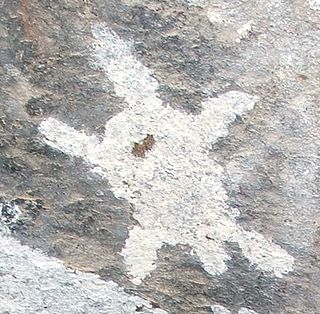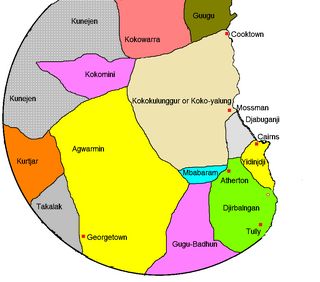Related Research Articles

The Ngunnawal people, also spelt Ngunawal, are an Aboriginal people of southern New South Wales and the Australian Capital Territory in Australia.

The Gamilaraay or Kamilaroi language is a Pama–Nyungan language of the Wiradhuric subgroup found mostly in south-eastern Australia. It is the traditional language of the Gamilaraay (Kamilaroi), an Aboriginal Australian people. It has been noted as endangered, but the number of speakers grew from 87 in the 2011 Australian Census to 105 in the 2016 Australian Census. Thousands of Australians identify as Gamilaraay, and the language is taught in some schools.

Giimbiyu is an extinct Aboriginal Australian language isolate once spoken by the Giimbiyu people of northern Australia.

The Adnyamathanha language, also known as yura ngarwala and other names, and Kuyani, also known as Guyani and other variants, are two closely related Australian Aboriginal languages. They are traditional languages of the Adnyamathanha of and the Kuyani peoples, of the Flinders Ranges and to the west of the Flinders respectively, in South Australia.
Jukun or Djugun is an Australian Aboriginal language of Western Australia. There are no longer any fluent speakers of Jukun, but some people may remember it to some degree. It is an Eastern Nyulnyulan language, closely related to Yawuru.

Yarli (Yardli) was a dialect cluster of Australian Aboriginal languages spoken in northwestern New South Wales and into Northeastern South Australia individually Malyangapa (Maljangapa), Yardliyawara, and Wadikali. Bowern (2002) notes Karenggapa as part of the area, but there is little data.
Dhudhuroa is an extinct Australian Aboriginal language of north-eastern Victoria. As it is no longer spoken, Dhudhuroa is primarily known today from written material collected by R. H. Mathews from Neddy Wheeler. It has gone by numerous names, including Dhudhuroa, the Victorian Alpine language, Dyinningmiddhang, Djilamatang, Theddora, Theddoramittung, Balangamida, and Tharamirttong. Yaitmathang (Jaitmathang), or Jandangara (Gundanora), was spoken in the same area, but was a dialect of Ngarigu.

The Yuin–Kuric languages are a group of mainly extinct Australian Aboriginal languages traditionally spoken in the south east of Australia. They belong in the Pama–Nyungan family. These languages are divided into the Yuin, Kuri, and Yora groups, although exact classifications vary between researchers. Yuin–Kuric languages were spoken by the original inhabitants of what are now the cities of Sydney and Canberra.
Bidjara, also spelt Bidyara or Pitjara, is an Australian Aboriginal language. In 1980, it was spoken by 20 elders in Queensland between the towns of Tambo and Augathella, or the Warrego and Langlo Rivers. There are many dialects of the language, including Gayiri and Gunggari. Some of them are being revitalised and are being taught in local schools in the region. The various dialects are not all confirmed or agreed by linguists.

The Warrwa language is an extinct Australian Aboriginal language which was formerly spoken in the Derby Region of Western Australia near Broome, Western Australia. It may have been a dialect of Nyigina. It was also known as Warrawai or Warwa.
Marranj is an Australian Aboriginal language, a dialect continuum consisting of Maranunggu, Menhthe, and Emmi.
Alawa (Galawa) is a moribund Indigenous Australian language spoken by the Alawa people of the Northern Territory. In 1991, there were reportedly 18 remaining speakers and 4 semi-speakers.
Gurdjar (Kurtjar) is a Paman language of the Cape York Peninsula, Queensland, Australia. There are two dialects, Gurdjar proper (Gunggara), and Rip. Kunggara is another name for one or the other.
Mbara, and Yanga are mutually intelligible but separate Aboriginal language of Queensland, both now extinct. Glottolog assigns a code to a group level as Mbara-Yanga (mbar1254). Yanga is not to be confused with the Yangga language, a dialect of Biri.

Wamin, also known as Agwamin or Ewamian, is an Australian Aboriginal language of North Queensland spoken by the Ewamian people. Wamin was traditionally spoken in the Etheridge region, in the areas around Einasliegh, Georgetown, and Mount Surprise.
Yanda is an extinct and nearly unattested Australian Aboriginal language of Queensland. It was apparently close to Guwa.

The Ngarigo people are Aboriginal Australian people of southeast New South Wales, whose traditional lands also extend around the present border with Victoria. They are named for their language, Ngarigo, which in the 19th century was said to be spoken by the Nyamudy people.
The Djilamatang were thought to be a distinct Indigenous Australian people of the state of Victoria, Australia. This has recently been questioned by Ian Clark.
The Jaitmatang, also spelled Yaithmathang, are an Indigenous Australian people of the State of Victoria.
References
- ↑ Ngarigo at Ethnologue (19th ed., 2016)

Jaitmathang at Ethnologue (19th ed., 2016)
- 1 2 S46 Ngarigo at the Australian Indigenous Languages Database, Australian Institute of Aboriginal and Torres Strait Islander Studies
- ↑ Koch, Harold (2016). Documentary sources on the Ngarigu language: the value of a single recording.
- ↑ Hercus, Luise A. (1969). The Languages of Victoria: A Late Survey. Canberra: Australian Institute of Aboriginal Studies. pp. 199–200.